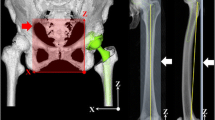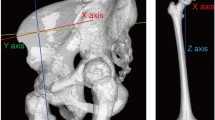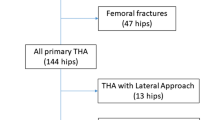Abstract
Purpose
Compared to medial femoral offset (MFO), the role of anterior femoral offset (AFO) on range of motion (ROM) in total hip arthroplasty (THA) has not been fully examined. We therefore defined AFO as the anterior distance from the centre of the femoral head to the proximal femoral axis in the sagittal plane and determined the optimal AFO required for ROM needed for activities of daily living using a computer-simulated THA model.
Methods
Various AFOs were obtained by changing stem anteversion (stem-AV) and stem tilt in the sagittal plane (stem-tilt) using a CT-based simulation software. The required ROM was defined as: flexion ≥ 110°, internal rotation at 90° flexion (IR) ≥ 30°, external rotation (ER) ≥ 30°, and extension ≥ 30°, and we determined AFO and MFO to satisfy required ROM.
Results
AFO was positively correlated with stem-AV and anterior stem-tilt. MFO was negatively correlated with stem-AV and not influenced by stem-tilt. Flexion and IR increased with both increased AFO and MFO, whereas extension and ER decreased with increased AFO. A smoothing spline curve showed the optimal AFO and MFO for required ROM to be from 15 mm to 25 mm on average and more than 32.1 mm, respectively.
Conclusions
This is the first study to show that AFO directly influenced ROM in THA. Optimal AFO as well as MFO should be reconstructed to achieve sufficient ROM.





Similar content being viewed by others
References
Lewinnek GE, Lewis JL, Tarr R, Compere CL, Zimmerman JR (1978) Dislocations after total hip-replacement arthroplasties. J Bone Joint Surg Am 60(2):217–220
Jolles BM, Zangger P, Leyvraz PF (2002) Factors predisposing to dislocation after primary total hip arthroplasty: a multivariate analysis. J Arthroplasty 17(3):282–288
Widmer KH, Zurfluh B (2004) Compliant positioning of total hip components for optimal range of motion. J Orthop Res 22(4):815–821
Malik A, Maheshwari A, Dorr LD (2007) Impingement with total hip replacement. J Bone Joint Surg Am 89(8):1832–1842
McGrory BJ, Morrey BF, Cahalan TD, An KN, Cabanela ME (1995) Effect of femoral offset on range of motion and abductor muscle strength after total hip arthroplasty. J Bone Joint Surg (Br) 77(6):865–869
Matsushita A, Nakashima Y, Jingushi S, Yamamoto T, Kuraoka A, Iwamoto Y (2009) Effects of the femoral offset and the head size on the safe range of motion in total hip arthroplasty. J Arthroplasty 24(4):646–651
Lakshmanan P, Ahmed SM, Hansford SM, Hansford RG, Woodnutt DJ (2008) Achieving the required medial offset and limb length in total hip arthroplasty. Acta Orthop Belg 74(1):49–53
Lincoln M, Johnston K, Muldoon M, Santore R (2009) Combined arthroscopic and modified open approach for cam femoroacetabular impingement: a preliminary experience. Arthroscopy 25(4):392–399
Girard J, Krantz N, Bocquet D, Wavreille G, Migaud H (2012) Femoral head to neck offset after hip resurfacing is critical for range of motion. Clin Biomech 27(2):165–169
Shoji T, Yasunaga Y, Yamasaki T, Mori R, Hamanishi M, Ochi M (2013) Bony impingement depends on the bone morphology of the hip after total hip arthroplasty. Int Orthop 37(10):1897–1903
Iwai S, Kabata T, Maeda T, Kajino Y, Watanabe S, Kuroda K, Fujita K, Hasegawa K, Tsuchiya H (2014) Three-dimensional kinetic simulation before and after rotational acetabular osteotomy. J Orthop Sci 19(3):443–450
Murray DW (1993) The definition and measurement of acetabular orientation. J Bone Joint Surg (Br) 75(2):228–232
Bargar WL, Jamali AA, Nejad AH (2010) Femoral anteversion in THA and its lack of correlation with native acetabular anteversion. Clin Orthop Relat Res 468(2):527–532
Müller M, Crucius D, Perka C, Tohtz S (2011) The association between the sagittal femoral stem alignment and the resulting femoral head centre in total hip arthroplasty. Int Orthop 35(7):981–987
Hirata M, Nakashima Y, Ohishi M, Hamai S, Hara D, Iwamoto Y (2013) Surgeon error in performing intraoperative estimation of stem anteversion in cementless total hip arthroplasty. J Arthroplasty 28(9):1648–1653
Nakashima Y, Sato T, Yamamoto T, Motomura G, Ohishi M, Hamai S, Akiyama M, Hirata M, Hara D, Iwamoto Y (2013) Results at a minimum of 10 years of follow-up for AMS and PerFix HA-coated cementless total hip arthroplasty: impact of cross-linked polyethylene on implant longevity. J Orthop Sci 18(6):962–968
Nadzadi ME, Pedersen DR, Yack HJ, Callaghan JJ, Brown TD (2003) Kinematics, kinetics, and finite element analysis of commonplace maneuvers at risk for total hip dislocation. J Biomech 36(4):577–591
Hemmerich A, Brown H, Smith S, Marthandam SS, Wyss UP (2006) Hip, knee, and ankle kinematics of high range of motion activities of daily living. J Orthop Res 24(4):770–781
Sugano N, Tsuda K, Miki H, Takao M, Suzuki N, Nakamura N (2012) Dynamic measurements of hip movement in deep bending activities after total hip arthroplasty using a 4-dimentional motion analysis system. J Arthroplasty 27(8):1562–1568
Kessler O, Patil S, Wirth S, Mayr E, Colwell CW Jr, D’Lima DD (2008) Bony impingement affects range of motion after total hip arthroplasty: A subject-specific approach. J Orthop Res 26(4):443–452
Cinotti G, Lucioli N, Malagoli A, Calderoli C, Cassese F (2011) Do large femoral heads reduce the risks of impingement in total hip arthroplasty with optimal and non-optimal cup positioning? Int Orthop 35(3):317–323
Tannast M, Kubiak-Langer M, Langlotz F, Puls M, Murphy SB, Siebenrock KA (2007) Noninvasive three-dimensional assessment of femoroacetabular impingement. J Orthop Res 25(1):122–131
Preininger B, Schmorl K, von Roth P, Winkler T, Matziolis G, Perka C, Tohtz S (2012) Femoral offset (3D) in patients without osteoarthritis - index values from 200 hip joints. Open Orthop J 6:578–581
Pasquier G, Ducharne G, Ali ES, Giraud F, Mouttet A, Durante E (2010) Total hip arthroplasty offset measurement: is CT scan the most accurate option? Orthop Traumatol Surg Res 96(4):367–375
Acknowledgments
This work was supported by a Grant-in-Aid for Scientific Research from the Japan Society for the Promotion of Science (No. 24592268). We thank Junji Kishimoto, a statistician from the Digital Medicine Initiative, Kyushu University, for his valuable comments and suggestions in regards to the statistical analysis.
Conflict of interest
The authors declare that they have no conflict of interest.
Author information
Authors and Affiliations
Corresponding author
Rights and permissions
About this article
Cite this article
Hirata, M., Nakashima, Y., Hara, D. et al. Optimal anterior femoral offset for functional range of motion in total hip arthroplasty—a computer simulation study. International Orthopaedics (SICOT) 39, 645–651 (2015). https://doi.org/10.1007/s00264-014-2538-0
Received:
Accepted:
Published:
Issue Date:
DOI: https://doi.org/10.1007/s00264-014-2538-0




